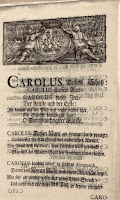After I posted a previous blog about the passage in Apologia Poetica in which Bessler discusses the use of crossbars in his machine I sought some further insight into the text. In the translation which I published in my biography of Bessler, he seems to be saying that when he first built his machine he used one crossbar but the wheel barely moved. He then tells us that when he added more crossbars, plus weights, pulleys and cord, the wheel spun more quickly. However I have studied the original German text and there are some interesting aspects to it which I think help explain what Bessler wanted us to understand from it.
The first thing I always thought odd was the addition of more weights pulleys and cords in the second part of the passage. It seemed to me that they should have been included with the first reference to crossbars. Then he could have said that more of each were needed. My initial conclusion was that Bessler was informing us of the presence of crosses i.e, part of a scissor mechanism, which I still think he was, but also of weights, pulleys and cords. However subsequently I considered that there were two or three pieces of information being presented within one piece of text, using a trick he has used elsewhere.
My translator thought that ‘crossbar’ was the word Bessler intended, and there has been much discussion about whether he actually meant ‘cross’ and not ‘crossbar’. The word ‘cross’ could suggest a design using the shape of a cross, in other words four equal divisions within the wheel. However I discovered a word which one might gloss over but which gives us a clue to his thinking.
So a closer study of the words he used reveals more information than one might get at first. This is my latest interpretation. The first words below are from my original version of Apologia Poetica, Part 2, XXXIII
"If I arrange to have just one cross-bar in the
machine, it revolves very slowly, just as if it can hardly turn itself
at all, but, on the contrary, when I arrange several crossbars, pulley and weights, the machine can revolve much faster, and throw
Wagner's calculations clean out of the window!"
Now my new interpretation using equally acceptable alternative words:
"So in an earlier work, I used just (or only) a (or one) cross, so to speak (or as it were),
"So you will see it, is very slow and hard to turn around by itself; On the other hand, (or whereas) if I added more crosses, pulleys and weights, then the device can run much faster;"
The word used in the German text is
Gleichsam = so to speak, or as it were.
In the English dictionary, .
(definition of 'so to speak' = so to speak to draw attention to the fact that you are describing or referring to something in a way that may be amusing or unusual rather than completely accurate)
The word used in the German text is
Gleichsam = so to speak, or as it were.
In the English dictionary, .
(definition of 'so to speak' = so to speak to draw attention to the fact that you are describing or referring to something in a way that may be amusing or unusual rather than completely accurate)
With his first use of the word "Kreuze", he is saying that it is like a cross. In the second part he is saying, add these other parts, as well as more crossbars....... but he doesn't mean crosses. This is why the first use of the word Kreuze, is separate from the second use.
I believe his intention in the first use of the word "kreuze" was to confirm the need for five mechanisms and not four. So the first part is saying if you use four mechanisms the wheel will hardly turn, but if you use more by adding additional crossbars to the four you already have, then the wheel will turn fast.
So there are potentially three pieces of information; firstly, is that there needs to be more than four mechanisms; secondly, there is a portion at least of the scissor mechanism involved, and thirdly, he tells us that we need to add more crossbars, weights, pulleys and cord.
So there are potentially three pieces of information; firstly, is that there needs to be more than four mechanisms; secondly, there is a portion at least of the scissor mechanism involved, and thirdly, he tells us that we need to add more crossbars, weights, pulleys and cord.
JC















